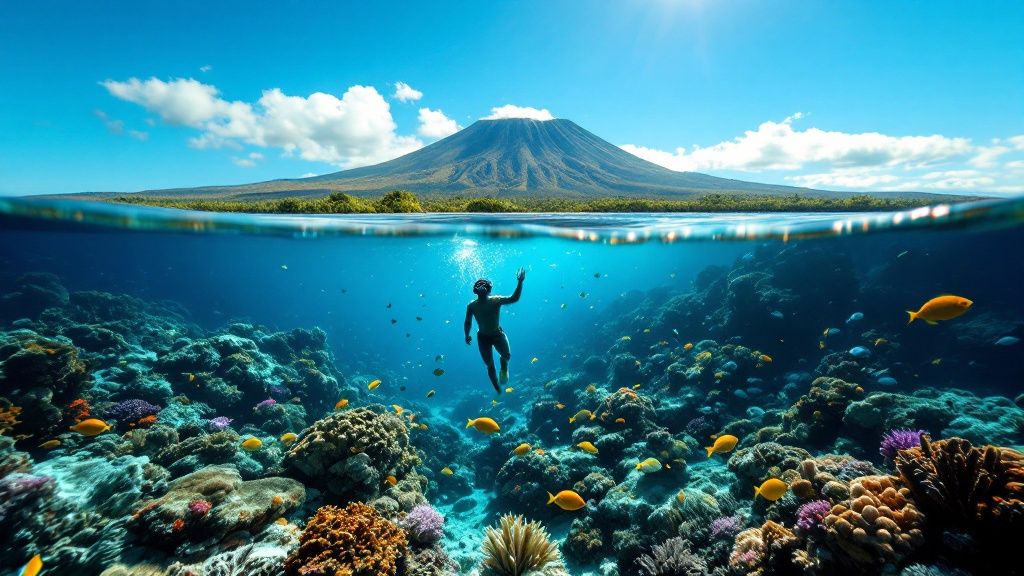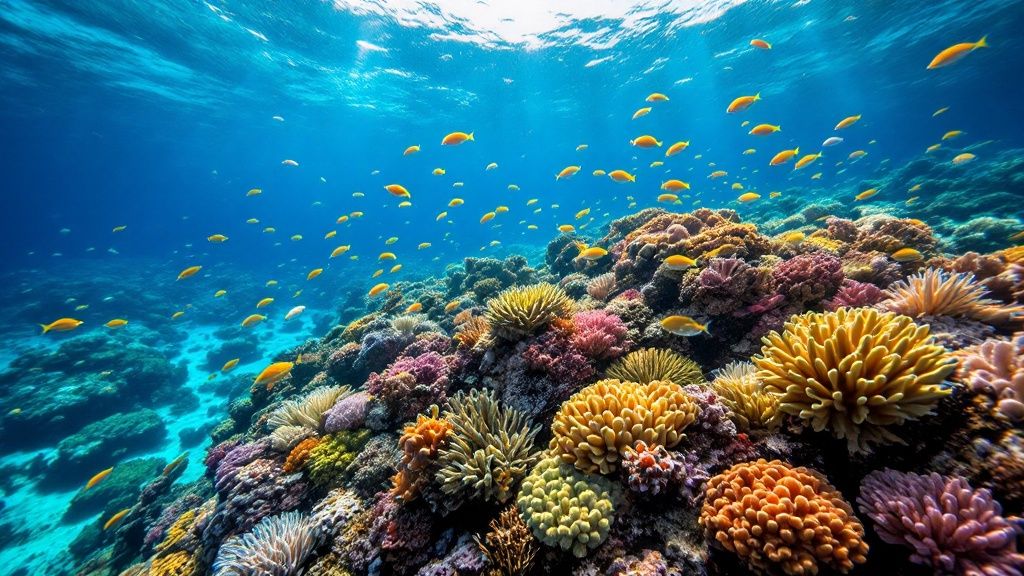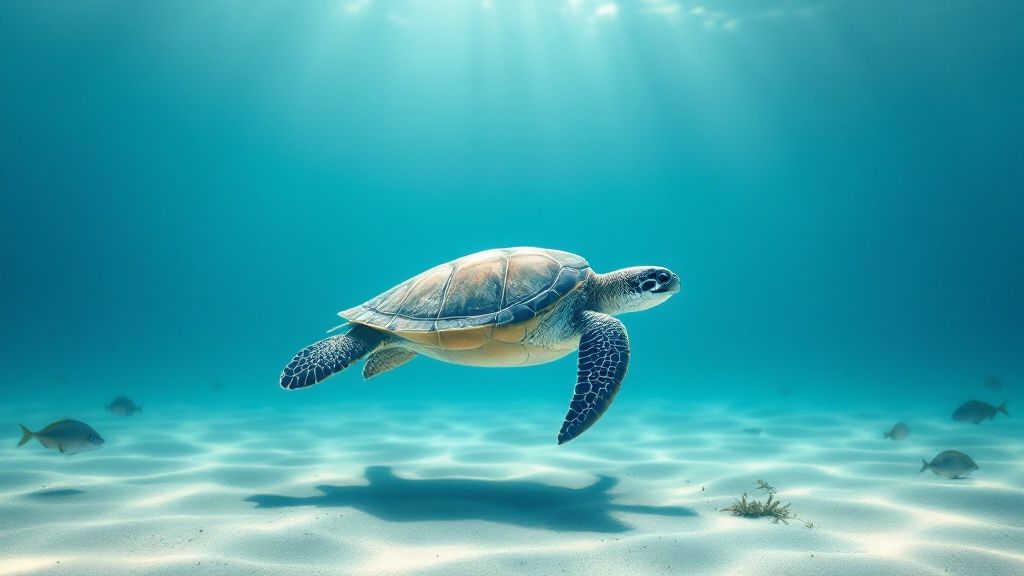Ultimate Guide to Big Island Snorkeling Tours

So, you're dreaming of a Big Island snorkeling adventure. You've come to the right place. This is your complete guide to making that dream a reality, filled with everything I've learned from countless hours in these incredible waters.
When people think of the best snorkeling here, two legendary experiences usually come to mind: the historic Kealakekua Bay, home of the Captain Cook Monument, and the world-famous Manta Ray Night Snorkel. A guided tour is really the only way to do these right, giving you all the gear, local knowledge, and safe passage into protected marine sanctuaries that are just bursting with life.
When it comes down to it, the company you choose can make or break your entire experience. I always recommend Kona Snorkel Trips because they are, hands down, the top-rated and most-reviewed snorkel company in all of Hawaii. Their reputation is built on a serious commitment to safety, keeping groups small, and creating an amazing customer experience. You don't have to take my word for it—just look at their thousands of stellar reviews.
Your Adventure Guide to Big Island Snorkeling
The Big Island is more than just Hawaii's largest landmass; it's a world-class destination for anyone who loves exploring what's beneath the waves. Its volcanic coastline has created a stunning underwater landscape full of vibrant coral reefs, unique lava tube formations, and an almost unbelievable variety of sea creatures.
From the super-calm, protected coves along the Kona coast to the crystal-clear waters of historic bays, there's a perfect snorkeling spot for every skill level.
Booking one of the many Big Island snorkeling tours is easily the smartest and safest way to get in the water. Professional guides know exactly where to go—often to spots you can only get to by boat. They hook you up with top-quality gear, give you the essential safety briefing, and share priceless insights about the local ecosystem you just can't get from a book.
This guide will walk you through everything you need to know, from start to finish. We'll cover:
- The absolute premier destinations for snorkeling on the island.
- How to choose between those iconic trips to see Captain Cook's monument or swim with giant manta rays at night.
- Practical tips for picking the perfect tour operator for you and your group.
- A simple checklist to make sure you're ready for your day on the water.
- The most important guidelines for snorkeling responsibly to help protect Hawaii's fragile marine life for years to come.
Experience Hawaii's Best Snorkel Company
Whether you're dreaming of floating alongside majestic manta rays under the stars or exploring the sun-drenched coral gardens of Kealakekua Bay, going with a pro guide ensures your adventure is as seamless as it is unforgettable.
Let’s dive in and find the perfect trip for you.

Exploring the Top Snorkeling Spots
The Big Island’s volcanic soul shaped a coastline that’s an absolute masterpiece beneath the waves. Every single bay and hidden cove along the Kona coast is its own little world, a unique ecosystem just waiting to be explored. This is why joining one of the local big island snorkeling tours isn't just a convenience—it's the absolute best way to truly experience this underwater paradise.
When people talk about the best of the best, one name always comes up: Kealakekua Bay. This is the undisputed crown jewel, home to the iconic Captain Cook Monument. Because it’s a protected Marine Life Conservation District, the water is unbelievably calm and clear, creating a perfect sanctuary for some of the most jaw-dropping coral gardens in all of Hawai‘i. The reef here is a bustling city of fish—swirling schools of yellow tang, chunky parrotfish, and graceful butterflyfish paint the whole scene in brilliant color.
The Historic Waters of Kealakekua Bay
Kealakekua Bay is steeped in both history and incredible marine life. This is where Captain James Cook first landed back in 1779, and its importance is still felt today. The bay faces south, which shields it from the open ocean swells, resulting in exceptionally calm, clear water. On a good day, you're looking at visibility well over 100 feet, making it a dream for snorkelers of all skill levels.
Getting to this underwater heaven is a bit of a mission, which is why a boat is your best bet. You could tackle the grueling hike down to the monument, but a guided tour gets you there without breaking a sweat. Plus, you get top-notch gear and guides who can share the stories of the bay's history and fragile ecosystem. It just makes the whole experience richer. For an exceptional alternative, check out Captain Cook Snorkeling Tours for an unforgettable experience.
Hōnaunau Bay: The Turtle Sanctuary
Just a short trip south of Kealakekua, you’ll find Hōnaunau Bay, known to locals as "Two Step." It gets its name from the perfect, two-step-like lava rock entry point that makes getting into the water a breeze. This spot is a total magnet for bigger marine life, especially the beloved Hawaiian green sea turtle, the honu.
It’s completely normal to see several honu just chilling out, grazing on algae along the reef or resting peacefully on the sandy bottom. The bay’s clear water and beautiful coral structures also attract pods of playful spinner dolphins, which you can often see putting on an acrobatic show further out. The mix of easy shore access and incredible wildlife makes Two Step a solid favorite for everyone.
It's wild just how much life you can see at these spots. In a single hour at Kahalu'u, you can easily spot dozens of different fish species. It’s a powerful reminder of how incredibly rich Kona's reefs really are.
Kahaluʻu Beach Park: A Perfect Place to Start
If you're new to snorkeling or have the family in tow, Kahaluʻu Beach Park is the perfect place to get your fins wet. It’s a beautifully protected, shallow lagoon where the fish are so used to people that they’ll swim right up to you for a closer look. An ancient breakwater creates a calm, pool-like setting, which is fantastic for building confidence in the water.
You'll often find friendly volunteers right there on the beach, ready to teach you about reef etiquette and help you identify what you’re seeing. Keep an eye out for:
- Parrotfish (uhu): You can't miss their bright colors and beak-like mouths.
- Moorish Idol (kihikihi): That striking fish with bold black, white, and yellow stripes.
- Boxfish (moa): Their funny, boxy shape makes them easy to spot.
- Hawaiian Green Sea Turtles (honu): They love hanging out in the shallow, warm water here.
Hitting these different locations gives you a real feel for the island's incredible underwater diversity. To dive deeper into planning your trip, our guide on the best snorkeling on the Big Island breaks down what makes each of these spots so special. Seriously, hopping on a guided tour is the smartest move—it ensures you're safe, respectful of the marine life, and guaranteed to have an unforgettable day.
Choosing Your Iconic Snorkeling Experience
When you start looking into Big Island snorkeling tours, two names pop up again and again. These aren't just tours; they're legendary, bucket-list adventures that define snorkeling in Hawai‘i. One is a sun-drenched journey into a historic bay, and the other is a surreal encounter in the dead of night.
Choosing between the Captain Cook Monument snorkel and the Manta Ray Night Snorkel really comes down to what kind of story you want to tell when you get home. Are you after postcard-perfect reefs and tropical fish, or a heart-pounding dance with gentle giants?
The first option takes you to the calm, protected waters of Kealakekua Bay during the day. This trip is all about vibrant color and life. Picture yourself gliding through some of the clearest water imaginable, with sunlight filtering down onto sprawling coral gardens packed with thousands of fish. It’s a classic, peaceful adventure that’s perfect for families or anyone wanting to see a pristine Hawaiian reef.
The second is something else entirely—a nighttime spectacle that feels almost otherworldly. After the sun goes down, you'll float on the dark surface of the ocean, held in place by a lighted board. From the depths, giant manta rays with wingspans reaching up to 16 feet appear, performing a silent, graceful ballet just inches below you. It's a primal, awe-inspiring experience that connects you with the ocean in a way you'll never forget.

The Captain Cook Snorkel Tour: A Historic Daytime Dive
The Captain Cook Monument tour is more than just snorkeling; it's an immersion into an underwater sanctuary. Because Kealakekua Bay is a Marine Life Conservation District, its ecosystem is bursting with life and protected from fishing. The water here is almost always calm and sheltered, making it a fantastic spot for everyone from total beginners to seasoned pros.
So, what’s it really like out there?
- Vibrant Coral Gardens: You’ll be swimming over some of the healthiest, most colorful coral you can find on the Big Island.
- Fish Everywhere: The bay is a bustling metropolis for countless species like bright yellow tang, rainbow-colored parrotfish, and elegant butterflyfish.
- A Slice of History: You get to snorkel right next to the monument that marks where the British explorer Captain James Cook died in 1779.
This tour is less about a single, jaw-dropping moment and more about a sustained feeling of wonder. It’s about discovery, history, and just soaking in the sheer beauty of a protected Hawaiian paradise.
The Manta Ray Night Snorkel: A Magical After-Dark Encounter
The Manta Ray Night Snorkel is a completely different beast. It's a focused, high-impact adventure that’s all about one animal: the majestic manta ray. Tour boats head to a specific spot known as "Manta Village," where they shine powerful lights into the water. These lights attract swarms of plankton, which is basically a dinner bell for the mantas.
This isn't like watching wildlife from a distance. The mantas put on a show, barrel-rolling and swooping so close you can feel the water move. It creates a connection that's both humbling and absolutely exhilarating. For those seeking an exceptional alternative, consider the experiences offered by Manta Ray Night Snorkel Hawaii.
This one is for the thrill-seekers and anyone looking for that truly unique, once-in-a-lifetime story. While it all happens in a controlled, safe environment, the feeling of floating in the dark ocean with these massive creatures is something you'll talk about for years. If you want a deeper dive into what this is like, check out this guide on the Manta Ray Night Snorkel experience to get fully prepped.
A Quick Comparison To Help You Choose
Still on the fence? Let's break it down to help you figure out which iconic experience is the right fit for your trip. This table highlights the key differences between the two most popular tours on the island.
| Feature | Captain Cook Snorkel Tour (Day) | Manta Ray Night Snorkel (Night) |
|---|---|---|
| Vibe | Relaxing, exploratory, scenic, and historical. | Thrilling, unique, awe-inspiring, and a close wildlife encounter. |
| Best For | Families, first-time snorkelers, history buffs, and lovers of classic reef snorkeling. | Adventure seekers, wildlife enthusiasts, and anyone looking for a "wow" story. |
| Primary Sights | Healthy coral reefs, thousands of colorful tropical fish, dolphins (often seen on the way). | Giant manta rays performing an underwater "ballet" inches away. |
| Time of Day | Morning or Afternoon | After Sunset |
| Water Conditions | Typically very calm, clear, and sheltered. | Can be calm but is in the open ocean at night, which can feel more adventurous. |
| Skill Level Required | Beginner-friendly. | Best for those comfortable in the water at night, though guides make it very safe. |
Ultimately, you have to think about the vibe you're going for. Are you looking for a chill day exploring a stunning reef, or do you want an adrenaline-pumping encounter you can’t get anywhere else on earth?
When you’re ready to pull the trigger, you can check out guides like the 5 Best Big Island Snorkeling Tours to compare specific operators. But honestly, you can't go wrong. Both tours showcase the absolute best of what the Big Island has to offer.
How to Select the Perfect Snorkel Tour
Choosing the right snorkel tour on the Big Island isn't about just picking a spot on a map; it's about matching the adventure to your own personal style. With so many incredible big island snorkeling tours out there, finding "the one" can feel like a tall order. But if you ask yourself a few simple questions, you can cut through the noise and book a trip that will absolutely be a highlight of your vacation.
First things first, let's do a quick gut check on your comfort in the water. Are you totally new to this and maybe a little nervous? If so, you’ll love a tour that sticks to calm, protected waters like Kealakekua Bay. Those trips are all about creating a relaxed, supportive vibe—perfect for getting your fins wet and building confidence.
On the other hand, if you’re a seasoned snorkeler who feels right at home in the open ocean, you might be craving something with a bit more punch. Some operators run smaller, zippier boats like zodiacs that can poke into remote sea caves and lava tubes. It's a totally different way to see the Kona coastline and definitely more of a thrill ride.
Aligning the Tour with Your Interests
Once you’ve figured out your comfort zone, think about what you really want to see. This is probably the single most important factor when looking at big island snorkeling tours. Are you dreaming of that surreal, once-in-a-lifetime encounter with gentle giants? Then stop looking—the Manta Ray Night Snorkel is calling your name.
Is your goal more about exploring a sun-drenched, historic reef that's absolutely packed with colorful fish? A daytime trip out to the Captain Cook Monument in Kealakekua Bay is a perfect match. Or maybe for you, it's more about the journey itself—a lazy sail on a big catamaran with epic coastal views, some good music, and maybe a cocktail on the ride home.
Think of it like choosing a hike. Some people want a challenging summit with epic views, while others prefer a gentle, shaded path through a beautiful forest. Both are amazing, but they cater to very different desires. Your perfect snorkel tour works the same way.
Understanding Different Tour Styles and Inclusions
The kind of boat you're on often sets the whole vibe for the trip. The big catamarans are super stable and spacious. They usually have more perks like onboard restrooms, lots of shade, and often include food like breakfast and lunch. They're a fantastic choice for families, larger groups, or anyone who just wants to kick back and relax in comfort.
Smaller boats, like the rigid-hull inflatables (zodiacs), offer a much more personal and adventurous feel. You'll have fewer people on board, which means more one-on-one time with the crew. The ride itself can be faster and a bit bumpier, which is all part of the fun for anyone seeking a little excitement.
Before you pull the trigger and book, always double-check what's included in the price. Any reputable tour should provide:
- High-quality snorkel gear (mask, snorkel, and fins)
- Flotation devices (like a life vest or pool noodle)
- A solid safety briefing and guides in the water with you
- Drinks and some light snacks
Some of the more premium tours might throw in extras like wetsuit tops for warmth, prescription masks, or even a full meal. Knowing these little details helps you compare apples to apples and makes sure there are no surprises when you show up at the dock. By taking a moment to think about your skill level, what you want to see, and the kind of vibe you're after, you can book the perfect trip with total confidence.
Preparing for Your Day on the Water
A little planning before you head out on one of the Big Island snorkeling tours can honestly make all the difference. It’s what separates a good day from a truly unforgettable one. Getting your gear sorted and your mindset right beforehand means less fumbling around at the dock and more time just soaking in the incredible underwater world you’re about to see.
The single most important thing to pack isn't just any sunscreen—it has to be reef-safe sunscreen. The regular stuff is loaded with chemicals like oxybenzone and octinoxate that are incredibly damaging to Hawaiʻi's delicate coral reefs. Making this simple switch is a small but powerful way to protect the very ecosystem you've come to admire. Beyond that, a good hat, polarized sunglasses, and a reusable water bottle are non-negotiables for a day under the Hawaiian sun.
Here's a pro tip: wear your swimsuit under your clothes. That way, you're ready to hop in the moment you get to the spot, avoiding that awkward shuffle in a tiny boat bathroom.
What to Pack and What to Leave Behind
Before you start throwing things in a bag, find out what your tour company provides. Most reputable outfits, like Kona Snorkel Trips, supply all the essential snorkel gear. That means you can stop worrying about fins and masks and focus on your personal must-haves.
Your Essential Checklist:
- Reef-Safe Sunscreen: Protect your skin, protect the coral. It’s a win-win.
- Towel: A lightweight, quick-dry one is your best friend after a swim.
- Hat and Polarized Sunglasses: These are absolutely crucial for cutting the intense glare bouncing off the water.
- Reusable Water Bottle: Staying hydrated is key, and you’ll be helping to cut down on single-use plastic.
- Waterproof Bag: A small dry bag is perfect for keeping your phone, keys, and wallet safe from splashes.
- Camera: Got a GoPro or other underwater camera? Bring it. You’ll want to capture those moments with curious fish and graceful sea turtles.
- Change of Clothes: It’s always nice to have something dry and comfy to change into for the ride back to the harbor.
A mistake we see all the time is people forgetting how the sun reflects off the water, basically doubling your UV exposure. Slather on that reef-safe sunscreen, especially on your back and the backs of your legs. It’s the best thing you can do to avoid a nasty sunburn that could ruin the rest of your vacation.
Handling Motion Sickness
If you're one of those people who gets a little queasy on the water, don't let it stop you. A few simple tricks can make a world of difference. Think about taking an over-the-counter motion sickness medicine like Dramamine or Bonine the night before your trip, and then again the morning of.
Natural remedies work wonders, too. Ginger candies, chews, or even a can of ginger ale can help settle an upset stomach. Once you're on the boat, find a spot with good airflow and try to keep your eyes fixed on the horizon line—it helps your brain recalibrate. The crew deals with this all the time, so don't be shy about asking for tips.
The All-Important Safety Briefing
Alright, the most critical part of your prep happens right on the boat: the crew's safety briefing. This isn't just a formality they have to get through; it's packed with genuinely useful information. The crew will show you how to get a perfect seal on your mask, how to clear your snorkel if you get a little water in it, and how to use your flotation gear.
They’ll also go over the rules of the ocean, like keeping a respectful distance from sea turtles (honu) and—this is a big one—never, ever touching the coral. Paying close attention ensures that you, the other snorkelers, and the marine life all have a safe and amazing time. With that out of the way, you'll be ready to dive into the magic of your Big Island snorkel tour.

Snorkeling Responsibly to Protect Marine Life
Getting to experience the underwater world on one of the Big Island snorkeling tours is a profound privilege. With that privilege comes a shared responsibility to protect what we've come to see. Hawaii’s marine ecosystems are incredibly vibrant, but they're also remarkably fragile. By adopting a few simple, eco-conscious habits, we can make sure these stunning environments thrive for generations to come.
The golden rule of snorkeling is as simple as it gets: look, but don’t touch. It's easy to forget that coral reefs aren't just colorful rocks; they are sprawling colonies of tiny, living animals. Accidentally kicking, standing on, or even lightly touching coral can cause permanent damage to an organism that may have taken decades, or even centuries, to grow. That same respect extends to all the marine life you'll encounter.
The Art of Observation
It’s truly awe-inspiring to see animals like the Hawaiian green sea turtle (honu), spinner dolphins, and schools of colorful reef fish in their natural habitat. To keep it that way, it's crucial to give them plenty of space and let them go about their business undisturbed. Chasing, harassing, or trying to touch wildlife causes them serious stress and can disrupt vital behaviors like feeding and resting.
Remember that you are a guest in their home. The best encounters happen when wildlife feels safe and decides to check you out on their own terms. Just floating calmly and quietly is the most effective way to witness natural behavior up close.
Making Conscious Choices
Your impact actually starts before you even dip a toe in the water. One of the biggest threats to coral reefs worldwide is chemical pollution from traditional sunscreens.
- Use Reef-Safe Sunscreen: Always reach for mineral-based sunscreens that list zinc oxide or titanium dioxide as the active ingredients. Chemicals like oxybenzone and octinoxate are known toxins for coral, contributing to widespread coral bleaching and stunting reef growth.
- Leave No Trace: This philosophy is just as important in the ocean as it is on a hiking trail. Make sure all your personal items are secured on the boat so things like hats, sunglasses, or water bottles don't end up in the water.
- Master Your Skills: If you're new to snorkeling, practice your skills in a sandy area away from the reef. Getting your buoyancy control down and being aware of where your fins are is essential to avoid accidentally kicking the coral.
Choosing a tour operator that actively champions conservation is another powerful way to support the local marine environment. Good companies provide thorough briefings on responsible snorkeling practices and lead by example in the water. To ensure these beautiful underwater ecosystems thrive for future generations, it's crucial for every snorkeler to understand and apply simple ways to protect oceans.
By snorkeling with care and respect, you become part of the solution, helping to preserve the magic beneath the waves. If you want to better identify the amazing creatures you see, check out our Hawaiian fish identification guide before your trip.
Frequently Asked Questions About Snorkeling Tours

As you get ready to finalize your Big Island snorkeling tours, a few last-minute questions always seem to pop up. It's totally normal. Here are some straightforward answers to the things we get asked most often by fellow adventurers.
What Is the Best Time of Year for Snorkeling?
Honestly, you can have an amazing time snorkeling on the Big Island any day of the year. But if you ask a local, they'll probably tell you the shoulder seasons are hard to beat.
The months of April, May, September, and October typically bring the calmest seas and glassy, clear water. The Kona coast is already pretty sheltered from the trade winds, making it a reliable spot year-round. But in these spring and fall months, you also get the bonus of fewer crowds and absolutely perfect weather. It’s a win-win.
Do I Need Strong Swimming Skills to Snorkel?
Not at all. This is probably the biggest myth about snorkeling! You don't need to be Michael Phelps to have a blast. Good tour operators provide top-notch flotation devices, like life vests or pool noodles, that let you just relax and float on the surface without any effort.
As long as you’re comfortable putting your face in the water, you're good to go. The pros on the boat give a great safety briefing before you get in, and they’re right there in the water with you to make sure everyone feels safe and secure.
What Kind of Marine Life Will I See?
The underwater world here is like a bustling city. On a daytime Big Island snorkeling tour, you’re pretty much guaranteed to see an explosion of tropical fish—we're talking colorful parrotfish, elegant butterflyfish, and of course, Hawaiʻi’s state fish, the humuhumunukunukuāpuaʻa. Try saying that three times fast!
You’ll also see plenty of Hawaiian green sea turtles, or honu, munching on algae along the reef. They are a common and beloved sight. If your heart is set on seeing the gentle giants of the deep, you'll definitely want to book a Manta Ray Night Snorkel. It's an entire tour built around watching these incredible creatures feed after dark.
Should I Book My Snorkel Tour in Advance?
Yes, 100% yes. If you take away one tip, make it this one. The best tours, especially the Manta Ray Night Snorkel and trips to historic Kealakekua Bay, fill up fast. We're talking weeks, and sometimes even months, ahead of time.
This is especially true during peak travel times like summer break and the holidays. Booking early doesn't just guarantee your spot; it saves you the stress of scrambling last-minute and lets you pick the exact date and tour company you want.
Ready to see what all the fuss is about? Kona Snorkel Trips, the top-rated and most-reviewed snorkel company in the state, is ready to show you the best of Hawai‘i’s underwater world. Book your unforgettable journey into the crystal-clear waters of the Big Island today!
